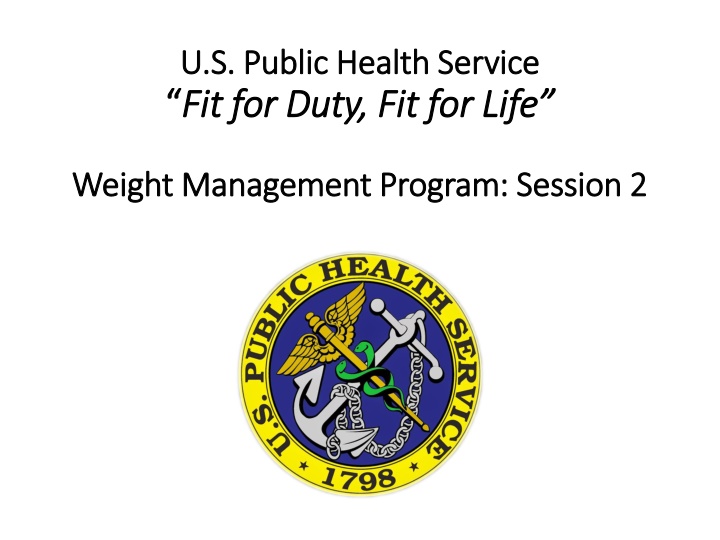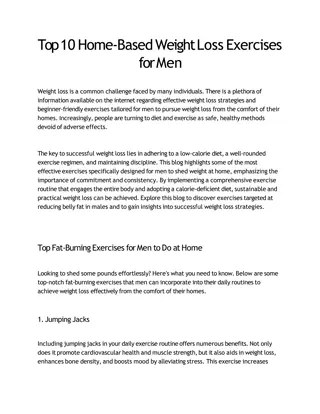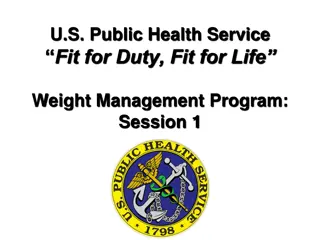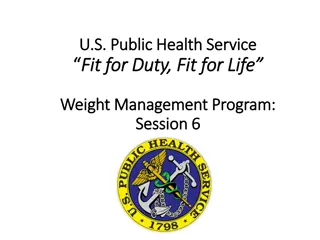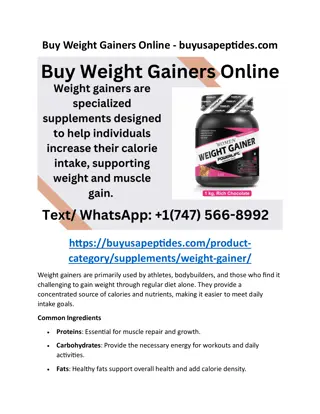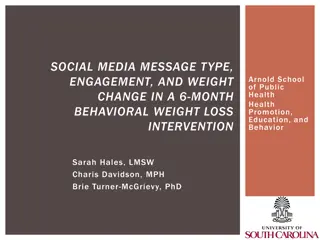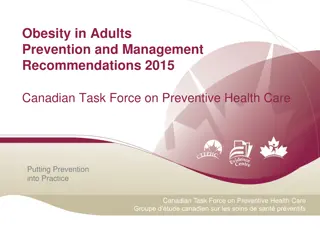Weight Management Program: Session 2 - Understanding Calories and Behavioral Goals
In this session of the Weight Management Program, the focus is on understanding calories, including their sources and impact on weight loss. Participants review assignments, set behavioral goals, and learn about the importance of calorie intake in achieving weight management goals. The session emphasizes identifying repeating patterns in food and activity records, setting effective behavioral goals, and making modifications for success.
Download Presentation

Please find below an Image/Link to download the presentation.
The content on the website is provided AS IS for your information and personal use only. It may not be sold, licensed, or shared on other websites without obtaining consent from the author.If you encounter any issues during the download, it is possible that the publisher has removed the file from their server.
You are allowed to download the files provided on this website for personal or commercial use, subject to the condition that they are used lawfully. All files are the property of their respective owners.
The content on the website is provided AS IS for your information and personal use only. It may not be sold, licensed, or shared on other websites without obtaining consent from the author.
E N D
Presentation Transcript
U.S. Public Health Service U.S. Public Health Service Fit for Duty, Fit for Life Fit for Duty, Fit for Life Weight Management Program: Session 2 Weight Management Program: Session 2
Topics for today Topics for today Review assignments from last week Calories and caloric density Healthy and not-so-healthy foods from each food group Meal replacements Food and beverage consumption during deployment These sessions are not meant to substitute for individual recommendations from your personal health care provider(s).
Review of last session Review of last session Introduction and course overview Benefits of a healthy weight Understanding body mass index (BMI) and how to calculate your BMI Setting a weight loss target goal Keeping food and activity records Looking for patterns Setting effective behavioral goals
Review of assignments: What did you learn? Review of assignments: What did you learn? Food and activity records Did you notice any repeating patterns? Did you identify any areas to target for improvement? Think about the timing of your meals and snacks should you be eating more or less often?
What did you learn? What did you learn? What are some behavioral goals that you set? Did you find these goals easy or difficult to attain? How could you modify these goals to make them more effective?
Calories Calories Calories = units of energy 1 calorie = amount of energy or heat required to raise the temperature of 1 gram water by 1 degree Celsius 1 gram of carbohydrate = 4 calories 1 gram of protein = 4 calories 1 gram of fat = 9 calories 1 gram of alcohol = 7 calories
Calories cont. Calories cont.
How many calories should I cut to lose weight? How many calories should I cut to lose weight? Recommended rate of weight loss: 1 to 2 pounds per week 3500 calories to lose 1 pound To lose 1 pound per week: Reduce your intake by 500 calories daily To lose 2 pounds per week: Reduce your intake by 1000 calories daily
What contains 500 calories? What contains 500 calories? = 1 super large soda = 2 cookies + 1 glass whole milk = 1 1/2 slices deep dish pizza
Healthy ways to cut calories Healthy ways to cut calories Reduce your intake of calories by 500-1000 each day. Visit ChooseMyPlate.gov To determine an appropriate daily calorie target for you, based on your age, sex, height, current weight, and physical activity level For a personal eating plan Cut back on the extras foods high in calories and low in nutrients Read labels for calories Focus on foods with low caloric density
Links to healthy eating plans Links to healthy eating plans ChooseMyPlate.gov Your Guide to Lowering Blood Pressure including the DASH diet plan starting on page 8
Calories: food labels Calories: food labels To determine how many calories a food has, check the Nutrition Facts label on the package 1. Check to see what the serving size amount is. 2. Check to see the number of servings in the package. 3. Determine the number of calories per serving of the food.
Caloric density Caloric density Concept in which foods with higher calories and smaller portions are less preferred to foods with higher volume and less calories. For example Low Caloric Density Foods High Caloric Density Foods Grapes Raisins Popcorn Nuts Plain Rice Cakes Granola Celery Avocado
Caloric density, cont. Caloric density, cont. Calorie Content High and Low Caloric Density Food Items Low Caloric Dense Food Serving Size of Low Caloric Density Food High Caloric Density Food Serving Size of High Caloric Density Food 300 Grapes 5 cups Raisins 2/3 cups 170 Popcorn 6 cups Nuts 24 nuts (1 ounce) 150 Celery 25 stalks Avocado medium
Dairy Group* Dairy Group* Instead of Replace with Whole milk Fat-free or low fat (1%) milk Sorbet, sherbet, or fat-free frozen yogurt Ice cream Reduced fat, light, or fat-free sour cream or cream cheese Sour cream or cream cheese Cheese (cheddar, jack, Swiss) Reduced fat made with 2% milk Low fat (1%) or reduced fat (2%) cottage cheese Regular (4%) cottage cheese * If you are lactose intolerant, lactose-free alternatives are available. Try soy, rice, or Lactaid milk. Soy and rice based ice creams are also available.
Grains Grains Instead of Replace with Plain whole grains like brown rice, whole wheat pasta or noodles Ramen noodles Pasta with white sauce (alfredo) Pasta with red sauce (marinara) Pasta with cheese sauce Pasta with vegetables (primavera) Crispy rice, cooked grits or oatmeal, cheerios, low-fat granola Granola
Protein Foods Protein Foods Instead of Replace with Cold cuts or lunch meats (bologna, salami, pepperoni) Turkey, ham, lean roast beef or lunch meats with 3grams fat/oz Hot dogs (regular) Lower fat or fat free hot dogs Bacon or sausage (regular) Canadian bacon or lean ham 90% or leaner ground beef or ground turkey Regular ground beef Chicken or turkey with skin, duck, goose Chicken or turkey without skin (white meat only) Water-packed tuna (rinse to reduce sodium content) Oil-packed tuna
Baked goods Baked goods Instead of... Replace with Hard French rolls or soft brown n serve rolls Croissants, brioches, etc. Donuts, sweet rolls, muffins, or pastries English muffins, bagels, reduced fat or fat free muffins and scones Party crackers Low fat crackers Cake (pound, chocolate, yellow) Cake (angel food, white, gingerbread) Reduced or fat free cookies (graham crackers, ginger snaps, fig bars) Cookies Recommend replacing with whole grain foods whenever possible
Snacks and sweets Snacks and sweets Instead of Replace with Popcorn (air-popped or light microwave) Nuts Fruit, popsicles, frozen yogurt, frozen fruit, or chocolate pudding bars Ice cream Custards or puddings (made with whole milk) Puddings made with skim milk * If you are lactose intolerant, lactose-free alternatives are available.
Fats, oils, and salad dressings Fats, oils, and salad dressings Instead of Replace with Light-spread margarines, whipped butter, tub or squeeze bottle Regular margarine or butter Light or fat free mayonnaise or mustard Regular mayonnaise Reduced calorie or fat free salad dressings, lemon juice, or plain, herb- flavored, or wine vinegar Regular salad dressing Nonstick cooking spray for stir-frying or saut ing, in baked goods use applesauce or prune puree Oils, shortening, or lard
Miscellaneous Miscellaneous Instead of Replace with Cream soups Broth-based soups Gravy (homemade with fat and/or milk) Gravy mixes made with water or homemade with the fat skimmed off and fat free milk included Fudge sauce Chocolate syrup Avocado on sandwiches Cucumber slices or lettuce leaves Guacamole dip or refried beans with lard Salsa
Fat matters, but calories count! Fat matters, but calories count! A calorie is a calorie whether it comes from fat, carbohydrate, or protein. But BEWARE - some fat free or reduced in fat foods may have the same number of calories as the regular version when other ingredients with calories replace the fat. Serving size Regular fat food Calories Comparable fat free/low fat food Calories cup Vanilla Ice Cream 104 Nonfat vanilla frozen yogurt 100 1 Blueberry Muffin 138 Low fat blueberry muffin 131 2 TBSP Peanut Butter 191 Reduced fat peanut butter 187
Meal replacements Meal replacements What is a meal replacement? A portion-controlled, prepackaged meal, fortified shake, or bar containing 150 - 300 calories 3 - 9 gm fat 10 - 20 gm protein 10 - 45 gm carbohydrate Should be used to replace an entire meal - NOT in addition to a meal
Meal replacements: Meal replacements: What is the evidence? Why do they work? What is the evidence? Why do they work? Research shows that meal replacements Are an effective way to reduce calories and promote weight loss Provide balanced meal Provide structure Simplify meal planning Promote consistent and accurate caloric intake Reduce shopping time Require little or no preparation Are easy to carry and store May cost less than a typical meal
How should meal How should meal replacements be used? replacements be used? Should be used to replace 2-3 meals/day and can also be used to replace snacks For example: - Breakfast - meal replacement shake - Lunch - meal replacement shake - Snack - prepackaged snack bar - Dinner - sensible dinner with salad, 3 oz piece of meat, fish, or chicken, and cup brown rice
Food and Beverage Consumption During Deployments PHS officers are often deployed under emergency circumstances and must endure harsh conditions. Consuming enough food and water is crucial for the maintenance of health during deployments. Officers should plan to bring enough water and non- perishable food to sustain themselves for at least 48 hours. Food provided for officers during deployments may not be nutritionally balanced and may lead to weight gain.
Common Nutrition-Related Issues During Deployments Weight loss if inadequate caloric consumption and/or high level of physical activity Weight gain if inactive and if consuming more calories than expending Constipation resulting from inadequate fluid and fiber intake Dehydration resulting from sweat losses and/or inadequate fluid intake
Meals Ready to Eat (MREs) MREs are complete meals designed and packaged for consumption by soldiers in the field MREs provide approximately 1/3 of daily needs of soldiers for calories, macronutrients, and micronutrients Each MRE contains approximately 1250 calories, 13% protein, 36% fat, and 51% carbohydrate MREs tend to be low in fiber and high in sodium PHS officers do not have the same nutritional requirements as soldiers in the field because: The average age of PHS officers is greater than that of soldiers and calorie needs decrease with age PHS officers are not expending as many calories and are usually not sweating as much as soldiers in the field MREs are calorically dense. PHS officers should decrease the amount of food consumed from the MRE based on physical activity in the field to prevent weight gain
Weight Maintenance During Deployments Food provided during deployments will often be high in calories and fat. To prevent weight gain, choose foods wisely. Take extra servings of fruits, vegetables, other high fiber foods to promote bowel regularity and to decrease calories consumed Bring pre-packaged, non-perishable foods such as protein and granola bars, meal replacement drinks, beef jerky, packets or cans of tuna, and peanut butter. You will be able to determine how many calories you are consuming by looking at the Nutrition Facts label. You do not have to eat an entire MRE at one meal! Split it between 2 meals or only eat the main dish and give the candy and snack foods to someone else. If possible, make a run to a grocery store to purchase healthy foods and snacks.
Hydration During Deployments Officers deployed to areas with very warm or very cold climates are at increased risk for dehydration and electrolyte (i.e. sodium, potassium, chloride, bicarbonate) imbalance It is recommended that officers bring a hydration system or canteen on all deployments Electrolyte replacement beverages such as sports drinks may be used during heavy labor or in hot climates
Summary of todays session Summary of today s session Review of last weeks assignments Discussed what calories are Discussed concept of caloric density MyPlate Discussed food groups and how to make good choices at meals/snacks Meal Replacements Food and beverage consumption during deployments
Assignments for next session Assignments for next session 1. Continue to keep food/activity log. Try using one of the specified web sites on the next slide. 2. Set 1-2 new behavioral goals. 3. Aim to reduce your daily intake by 500- 1000 calories. 4. Weigh yourself 2 times per week. 5. Check food labels for calorie amounts. 6. Apply knowledge learned in this class to make good food choices. Time Time Place Place Food/Beverage Food/Beverage Amount Amount Physical activity Physical activity 7 am 7 am Home Home Orange juice Orange juice 6 ounces 6 ounces Glazed donut Glazed donut 2 2 Coffee w/ sugar Coffee w/ sugar 16 ounces 16 ounces 7:45 am 7:45 am Walked to train (20 minutes) (20 minutes) Walked to train
Apps to help with keeping records Apps to help with keeping records Several Food Log or tracking apps are available for consumers today. Below are just a few of the options. Individual s are encouraged to find an app that meets your specific needs. MyFitnessPal Lose It! MyPlate Calorie Tracker Fat Secret Fooducate CalorieKing iTrackBites
